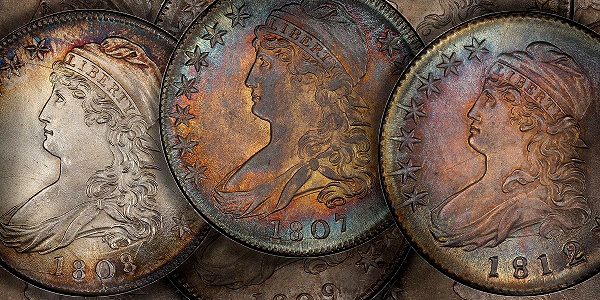Coin Rarities & Related Topics: News and Analysis regarding scarce coins, coin markets, and the coin collecting community #299
A Weekly CoinWeek Column by Greg Reynolds……
On Wed. Sept. 30, Stack’s-Bowers, in association with Sotheby’s, conducted the second in a series of auctions of the Pogue Family Coin Collection. Earlier this week, gold rarities were covered. In May, the first auction was reviewed. Here, the focus is on several gem quality, Capped Bust half dollars dating from 1807 to 1812, as most of these are really cool and fared particularly well. Generally, Capped Bust half dollars brought strong to very strong prices in the Pogue II auction.
“The 1807, 1808, 1811 and 1812 halves in the Pogue II sale were especially amazing,” declares Charles Link, the leading collector of Capped Bust half dollars. Link was a very active participant in this sale.
Reich Capped Bust half dollars, each of which has a ‘Lettered Edge,’ were minted from 1807 to 1836. Collectors seeking less expensive coins may wish to read about collecting Capped Bust halves for less than $500 each.
Only those dating from 1807 to 1822 were in this second Pogue sale. Reich Capped Bust halves dating from 1823 to 1836 may be included in the Pogue III sale in February.
The Flowing Hair and Draped Bust half dollars in the collection were in the Pogue I sale. The finest known pieces of the Draped Bust, Small Eagle design type were analyzed before that sale and in the first review. In addition, the finest known 1794 half dollar was in this collection. Some neat, Draped Bust, Heraldic Eagle halves were then included as well.
It is not practical to cover all the Capped Bust halves in the Pogue II sale here, even all those from 1807 to 1812. A few early gems brought surprisingly, very strong prices. At least three halves from the early 1820s realized newsworthy strong prices, too, and will be discussed in the future. Coins that were previously in the Eliasberg Collection are often emphasized, as Louis Eliasberg formed one of the all-time greatest collections of U.S. coins. The Pogues acquired an astonishing number of coins that were formerly in the Eliasberg Collection, including many coins of gem quality.
By tradition, gems are coins that grade 65 or higher on a scale from 01 to 70. In order to understand auction results, there is generally a need to reflect upon the physical characteristics of the respective coins. This is particularly true of Capped Bust halves.
While collectors of some series, such as Morgan dollars and Mercury dimes, tend to rely upon grades assigned by the grading services, collectors of Capped Bust halves are often less willing to accept grades and frequently discuss the grading of specific coins among themselves and favorite dealers.
For example, even a collector building a registry set of halves may turn down or avoid a certified “MS-66” grade coin that does not impress him, even though obtaining it would raise the score of a registry set, and be satisfied with a certified MS-62 to MS-65 grade coin, with which he is comfortable.
“The grade on the holder was not nearly as important as technical issues and eye appeal; bidders were thinking beyond the holders. There was a fairly sophisticated crowd chasing these kinds of coins, not depending on PCGS {or NGC} grades. To a sophisticated collector, a PCGS graded MS-66 coin will sometimes be worth more than a PCGS graded MS-67 coin of the same variety. For most coins that went strong, I understood why they went strong. In the end, it is about the coin, not the holder,” Charles Link explains.
Chuck is the leading collector of Capped Bust halves. Not all of his coins are publicly listed in any forum.
In the PCGS set registry, Link has the “All-Time Finest” set of business strike Capped Bust halves and the top ranked set of Capped Bust halves by die pairing. Dale Friend has the second “All-Time Finest” set of bust halves in more than one category in the PCGS set registry. Dale participated from a distance. Many other collectors bid on these half dollars, most of whom do not wish for their names to be mentioned.
1807
The Pogue I sale started with a bang! A PCGS graded MS-65 1807 half brought $129,250. “Although this was one of the most beautiful coins in the whole collection, I thought it would sell for less than $75,000,” states Richard Burdick. “This runaway price set the tone for a blockbuster sale of bust halves.”
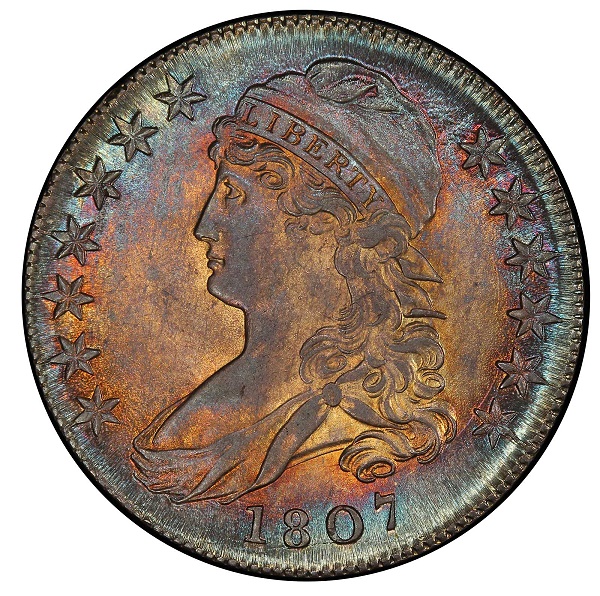
The Cornelius Vermeule 1807 50/20C Half Dollar
During 1807, both Draped Bust and Capped Bust half dollars were issued. Capped Bust halves were the lead-off coins in the Pogue II event. ‘Large Stars’ and ‘Small Stars’ varieties of 1807 halves are often collected as if they are distinct dates. Additionally, the ‘Large Stars’ variety with an overdenomination (50/20) error on the reverse (back of the coin) and the ‘Large Stars’ variety with a ‘normal’ denomination are sometimes collected as separate ‘dates ‘by people assembling sets of Capped Bust halves ‘by date.’
The overdenomination 1807 is by far the least scarce of these three major varieties. The Vermeule-Pogue piece is PCGS graded MS-65 and CAC approved. It is a tricky coin to grade. It has the eye appeal of a 66+ coin, with considerable imperfections underneath or within toning. The assigned 65 grade is a compromise or ‘net grade,’ in my estimation.
Before the auction, the PCGS price guide valued this coin at $37,500. The Gene Gardner coin of this same major variety is NGC graded as MS-65 and was auctioned in June 2014 for $28,200. This is not really a fair comparison, as the Gardner coin has problems. Although Gene may have formed the all-time greatest collection of 19th century U.S. silver series, that was not one of his best coins and is outside the primary themes of his collection.
In 2001, the Pogue coin realized $41,400, as part of the collection of Cornelius Vermeule, who owned an 1893-S silver dollar that is now the finest known. Vermeule was a well known museum curator and author. For this half, the Pogue II catalogue estimate of $25,000 to $35,000 seemed low.
Long before this auction, I figured $52,500 would have been a weak price, $65,000 a moderate price, and $80,000 a strong price. When bidding surpassed $100,000 before the start of the day on Sept. 29, I was intrigued. Are collectors extremely enamored by the color of this piece?
There are two others that are PCGS graded MS-65, including one owned by Dale Friend, a veteran specialist in half dollars. Moreover, it would be hard to envision this coin fairly being graded higher than MS-65 in the near future. The $129,250 result was surprisingly high. Even the more talkative members of the audience at the back of the ‘auction floor’ were stunned into silence.
The next lot was the Byers-Pogue 1807 with ‘Small Stars,’ which is PCGS graded as MS-65+. I covered the Stack’s sale of the George Byers Collection in October 2006. This ‘Small Stars’ 1807 then brought $51,750.
Before this ‘Small Stars’ 1807 was auctioned, PCGS CoinFacts valued it at $115,000, and listed $85,000 for a MS-65 grade coin. These numbers are puzzling. The Stack’s-Bowers catalogue put forth a range of $50,000 to $75,000, which is a fair representation of weak to strong market levels. The $76,375 result is certainly strong.
There has been much talk about the reality that the Kaselitz 1807 ‘Small Stars,’ which is also PCGS graded as “MS-65+,” realized substantially more, $129,250, at a Stack’s auction in July. The Kaselitz piece is CAC approved and the Byers-Pogue 1807 is not CAC approved, though perhaps would be judged to almost fulfill CAC criteria.
The next highest 1807 ‘Small Stars’ to be CAC approved grades MS-61. In my view, the Byers-Pogue and Kaselitz coins are close in overall grade, within a fraction of a point of each other. Nevertheless, the Kaselitz coin has much more eye appeal.
I will remember the neat blue toning of the Kaselitz 1807 for the rest of my life. The Kaselitz 1807 ‘Small Stars’ was a leading attraction of the Stack’s sale of the Douglas Kaselitz Collection in July.
Within the last five years, Richard Burdick attempted to place the Kaselitz coin in the Pogue Collection. “I made three aggressive offers to Julian Leidman who had it around 2010 and 2011. He sold it to Sheridan Downey who sold it Kaselitz in 2012. I then tried to buy it from Doug Kaselitz, who said it was absolutely not for sale,” recounts Richard Burdick. “Although they are both graded as MS-65+, there is no doubt in my mind that the Kaselitz coin is far superior to the Byers-Pogue coin,” Richard emphasizes.
Both the Kaselitz and Byers-Pogue 1807 ‘Small Stars’ coins are characterized by natural toning. In contrast, the PCGS graded MS-66 1807 ‘Large Stars,’ normal denomination, is much whiter than almost all of the other half dollars in the Pogue Collection. It is not one of the more original coins in this run of Pogue half dollars. It has obviously been dipped during the last twenty years. Natural retoning has started with mottled brown-russet overtones here and there. Some coins recover faster and/or better from dipping than others. (Please see my three part series on the basis for collecting naturally toned coins.)
This same Pogue ‘Large Stars’ 1807 was PCGS graded MS-65 when Heritage auctioned it for $149,500 in April 2010, a steep price at the time. The increase of one grading point for the same coin may have tremendous meaning for people assembling registry sets. In my mind, it is the same coin and merits the same grade that it did before.
“The 1807 large stars in 66 is an obviously dipped, too white coin, that some long time collectors did not like. Bringing $258,500 was a shock, but it is now PCGS graded as 66 and sold as a 65 the previous time,” notes Dale Friend.
Although there are certainly philosophical differences among collectors, this is, however, the finest known of the ‘Large Stars’ obverse coupled with a normal denomination reverse. These are extreme condition rarities in grades above MS-63.
The Newman 1807 Large Stars, Normal Denomination, which is NGC graded MS-65, realized $152,750 on November 15, 2013. There is agreement, though, that the overall numerical grade of the Pogue 1807 Large Stars, Normal Denomination, is slightly higher than that of the Newman coin, in accordance with PCGS or NGC criteria, though this difference in grade is very small.
In terms of PCGS or NGC criteria, the Pogue and Newman pieces may very well be the two finest of the Large Stars, Normal Denomination major variety of 1807 halves. Researcher Stephen Herrman reports that there is also an NGC graded MS-65 coin of this variety that was auctioned by Superior in October 2000.
“Despite the fact that it was dipped white, it was nearly flawless from a technical standpoint,” the buyer says, who declined to be named. Yes, for an uncirculated, 1807, Large Stars, Normal Denomination, half dollar, this coin scores the highest in the technical category. There are close to zero contact marks and hairlines that can be seen under five-times magnification. Also, it has a great deal of luster.
Two MS-67 1808 Halves
The Knoxville-Pogue 1808 is PCGS graded MS-67. Evidently, some serious bidders were comfortable with the assigned grade. The Knoxville collection was assembled during the late 1980s and early 1990s by a collector who was guided by Jay Parrino. It contained the all-time greatest type set of U.S. silver coins. The Knoxville Collection featured the Carter-Cardinal-Morelan 1794 dollar and included a few coins that were later in the epic type sets of Oliver Jung or James Lull.
Many certified “MS-67” silver coins have wonderful colors or are dazzling. The Knoxville-Pogue 1808 is a little subdued. I am enamored by its originality, however, and the russet, grey, blue and especially tan hues are soothing and stable. This coin is CAC approved.
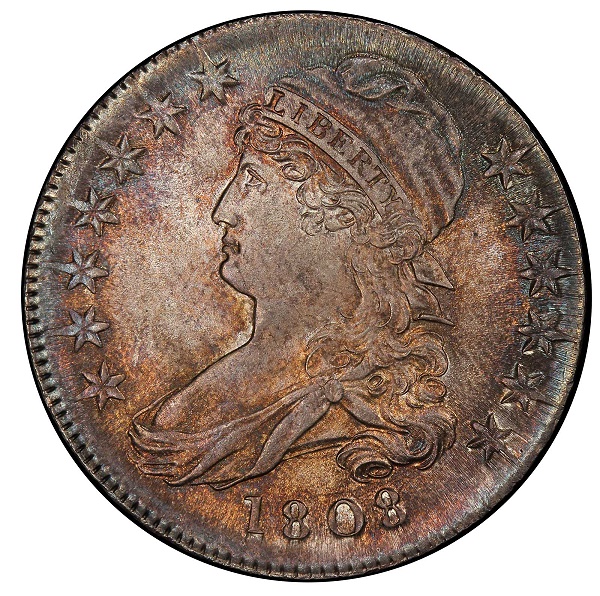
1808 Capped Bust Half Dollar – Knoxville Collection
The $88,125 result was very strong. Before this auction, a retail price for this coin would have been around $55,000 to $65,000. I would have doubted that a dealer would pay $50,000 to place it in inventory.
The next lot is not as “original”, though is impressive in some ways. The Browder-Pogue 1808, which is also graded as MS-67, very apparently has been dipped in the past. “Dipped but all there for a 7, technically almost perfect,” John Albanese states.
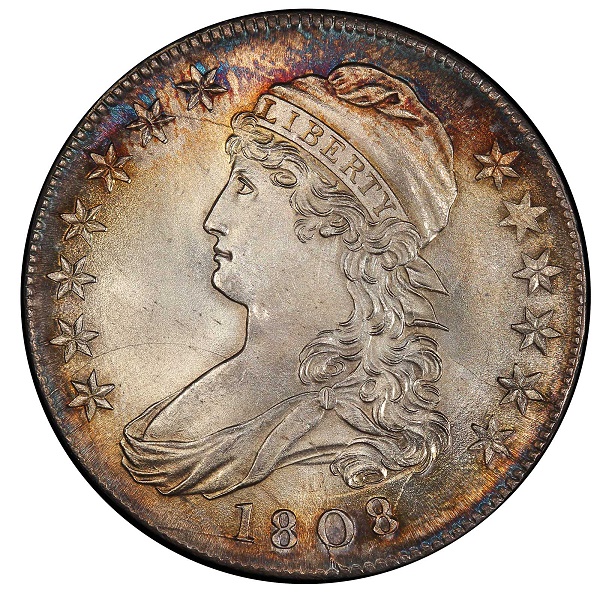
1808 Capped Bust Half Dollar – Browder Collection
The late Marvin Browder bragged about this coin after buying it in Auction ’90 in Rosemont, Illinois, for $33,000. It was then very bright white, almost like a lit light bulb, probably because it had been dipped not long before the Auction ’90 event. I noted that the fields were a little grainy from dipping. I politely congratulated him after he told me that he bought it.
This 1808 half was then NGC graded as MS-66. It has since naturally retoned to an extent.
The Browder-Pogue 1808 sold for $46,000 in a Heritage auction in January 2009, at a time when markets for rare coins were at lower levels than prevail currently. Even so, this coin might have a moderate value of $50,000 and an upper retail value of $75,000 at most.
As for the $99,875 result, more than twice the price in 2009, I am not putting forth an explanation. It is true that this is the highest certified of all 1808 halves of the same die pairing (O-109). In the minds of the leading bidders, is that a reason for a large premium? I do not know.
Earle-Eliasberg-Noblet 1809
The next lot, the Earle-Eliasberg-Noblet 1809, was a great value. It is just a wonderful coin, mostly original with evenly blended tan, gray and green tones. Russet hues in the outer fields are appealing. The underlying luster is lively. “Very frosty,” Albanese notes.
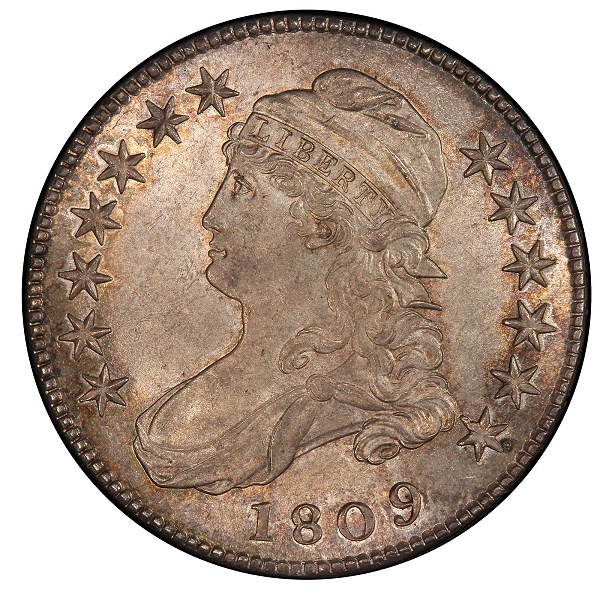
1809 O-106 Half Dollar – George H. Earle – Eliasberg
The $70,500 result was very strong. Relevant dealers would probably pay no more than $40,000 to inventory this coin. Nonetheless, the illustrious pedigree, the natural toning, the rich underlying luster and the superior technical characteristics all contribute to its importance and desirability. It was one of the greatest silver coins in the sale, and $70,500 was not a large amount in this auction. The new owner should be proud of his or her acquisition.
The PCGS graded MS-65 1809 “III Edge” is a little hard to explain, as it has a noteworthy edge and 1809 halves with such edge devices are often collected separately as a major variety. In any event, the 65 grade is fair enough. The level of strength of the $47,000 result is not clear, though it could not be weak.
Eliasberg 1811
The PCGS graded MS-67, Eliasberg-Pogue 1811 is amazingly original, has wonderful colors, and much underlying luster.
The reverse is indisputably superb with creamy russet inner fields and outer fields that exhibit brown, orange, red and green tones. The soft russet tones overall are stable and exceptionally pleasing. Though it is not flashy, this coin is nearly flawless. There is no doubt that it scores well into the 67 range in the technical category. The successful bidder, a dealer from the Midwest, has a reputation for being a sharp grader and a connoisseur of gem quality silver coins with natural toning.
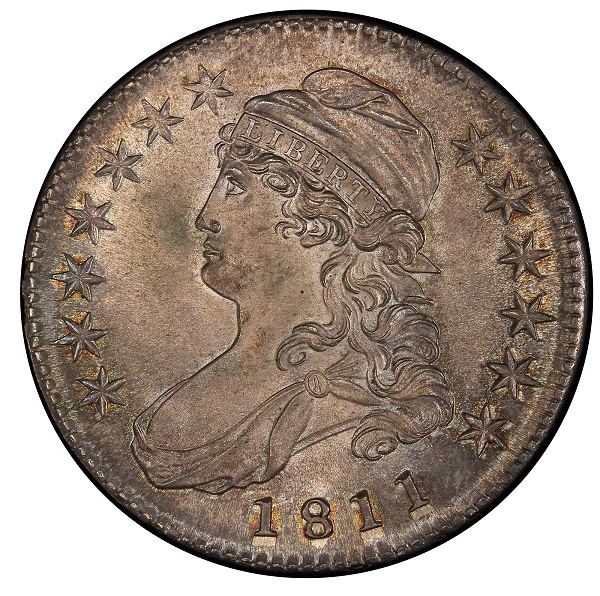
1811 Overton-108 Half Dollar Woodin-Clapp-Eliasberg
This is not a rare coin. The Eliasberg-Pogue 1811 is of the ‘Small 8’ major variety and thousands of these survive. Even so, this was one of the better values in the sale. It is relatively more original than the PCGS graded MS-67+ coin that Heritage auctioned in June 2013 for $94,000. For the same price, most sophisticated collectors would rather have this one.
At the Eliasberg ’97 event, this coin realized $28,600, a strong price at the time. Charlie Browne then graded it as “MS-66.” Browne has served as a grader for PCGS during four different eras, for maybe a total of more than one hundred months. I assign a grade in the low to middle of the 67 range to it now, and my guess is that Charlie would agree. Grade-inflation has occurred since 1997.
Eliasberg 1812
The Eliasberg-Pogue 1812, with normal numerals, is PCGS graded as MS-67 and CAC approved. It is a terrific coin and certainly scores in the 67 range in the technical category. There are hardly any contact marks or hairlines. An issue is whether it has enough eye appeal for a 67 grade coin. John Albanese remarks that “1812 halves come matte, not frosty, and this coin is technically almost perfect.”

1812/1 Capped Bust Half Dollar. Overton-102
I emphasize that it has an almost perfect score in the category of originality, too. It has almost certainly never been dipped and there is no evidence of a cleaning. The russet Miss Liberty contrasts well with green obverse outer fields.
In 1997, Charlie Browne graded this coin as “MS-66+.” It is not unusual for a coin that graded in the high end of the 66 range in 1997 to merit a grade in the middle of the 67 range now.
In 1997, this 1812 half sold for $26,400, a substantial amount at the time. The $82,250 result now was very strong. This is not close to being a rare coin, and many uncirculated 1812 halves survive. PCGS or NGC graded MS-66 1812 halves tend to sell at auction for between $9,000 and $19,000.
As the only 1812 that has been graded MS-67 by PCGS or NGC, it is clear that, before this auction, the PCGS price guide value for this coin was $57,500 and the NGC guide value was $50,000. The Numismedia “retail” value was $43,550. In my view, these numbers are not accurate. One reason is that certified MS-67 representatives of commensurable dates in the series have sold for significantly more than the amounts listed in such guides. A moderate price for this coin would have been below $60,000 and $65,000 would certainly have been a retail price. Even so, the $82,250 result is understandable. If I was interested in buying this coin, I would be willing to pay a substantial premium for its originality.
Afterthoughts
An interesting question is whether the Pogues formed the all-time greatest collection of Reich Capped Bust halves, those with a ‘Lettered Edge.’ The Pogue halves dating from 1823 to 1836 have not yet been publicized.
As many of the coins in the Eliasberg ’97 catalogue were then undergraded by the cataloguers and have been subject to grade-inflation in the interim, it is hard to fully evaluate the Eliasberg Collection in the present. Moreover, there was not nearly as much interest in gem quality Capped Bust halves in 1997 as there is now. Many of the Eliasberg Capped Bust halves were overlooked by experts who were focusing on other items in the same sale.
The Eliasberg ’97 event was conducted by Bowers & Merena (of New Hampshire) in New York. It was one of the greatest coin auctions of all time.
I have yet to attempt to analyze the offerings of halves in some of the epic sets auctioned by the Chapman firms from 1890 to 1921. It would be difficult to estimate the quality of those half dollars, as many have not been traced since or have changed in the interim. Moreover, Charles Link may have already formed the all-time best collection of bust halves. It does seem that the Pogue, Eliasberg and Link sets are all in the same league. Dale Friend’s set merits an honorable mention. Are there other sets that I am neglecting at the moment?
©2015 Greg Reynolds


